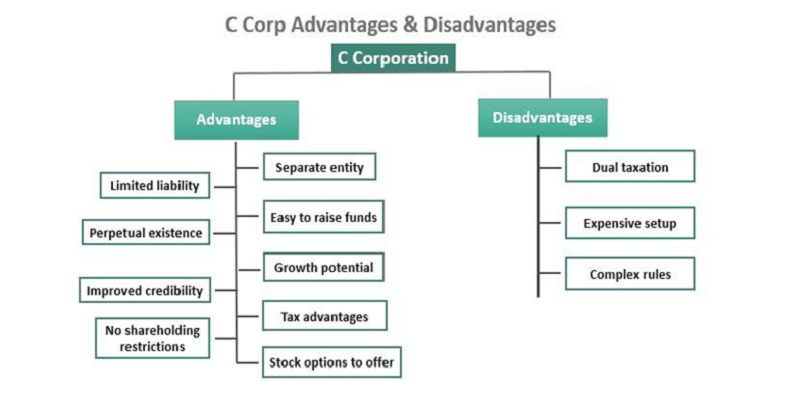
In the world of entrepreneurship, choosing the right business structure can be the defining line between success and failure. While many business owners are drawn to the allure of the C-Corporation structure due to its ability to attract investors, limit liability, and achieve perpetual existence, it’s not without its drawbacks. Here we look into complexities surrounding double taxation, rigid formalities, and significant administrative costs that entrepreneurs need to consider before making the leap.
Contents
Understanding C-Corporations
Before we explore the potential disadvantages, it’s important to have a solid understanding of what exactly a C-Corporation is and the benefits it typically offers. A C-Corporation, or C-Corp as it’s commonly known, is a legal structure for a corporation in which the owners, or shareholders, are taxed separately from the entity. This separate entity status confers many advantages which attract entrepreneurs worldwide.
Characteristics of C-Corporations
A C-Corporation has distinct features that make it stand out from other business structures like sole proprietorships, partnerships, or S-corporations.
- Separate Legal Entity: A C-Corporation is considered a separate legal entity from its owners. This means it can enter into contracts, sue or be sued in its own name. It offers a shield of liability protection for its owners, protecting personal assets from business debts and obligations.
- Perpetual Existence: A C-Corporation continues to exist even if the owners or major shareholders change or pass away. This continuity is crucial for businesses planning a long-term existence.
- Unlimited Potential Shareholders: Unlike S-Corporations, which have a limit of 100 shareholders, C-Corporations can have an unlimited number of shareholders, making it a preferred structure for companies that intend to go public.
- Attracting Investment: Because of its ability to issue various classes of stock, a C-Corporation can attract a broad range of investors, facilitating the process of raising capital.
Benefits of C-Corporations
Despite the focus of this article on downsides, there are undeniable advantages associated with the C-Corporation structure that make it an appealing choice for many businesses [1].
- Limited Liability Protection: The most significant benefit of a C-Corporation is the limited liability protection it offers its owners. Shareholders are typically not responsible for the corporation’s debts, so personal assets like homes or cars are safe even if the corporation runs into financial trouble.
- Ease of Raising Capital: By selling stock, C-Corporations can easily raise funds for expansion or other projects. This makes it an excellent structure for businesses planning significant growth or expansion.
- Ownership Transferability: The shares of a C-Corporation can be bought and sold without much hassle, enabling easy transfer of ownership.
- Tax Benefits: Despite the well-known issue of double taxation, C-Corporations do enjoy certain tax benefits, including a wide range of deductible business expenses.

Advantages of C-Corporations: A Recap
Now that we’ve explored the characteristics and benefits of C-Corporations in detail, let’s take a moment to succinctly recap the major advantages. Remember, these are the potential upsides that may lead many entrepreneurs to initially consider a C-Corporation structure.
Limited Liability
The foremost advantage of a C-Corporation is the limited liability protection it provides to its owners. In simple terms, this means that shareholders’ personal assets are generally safe from the reach of creditors, even if the corporation faces financial distress or legal issues.
Perpetual Existence
A C-Corporation enjoys perpetual existence, meaning the corporation continues to exist irrespective of changes in ownership or the death of shareholders. This continuity is particularly beneficial for businesses intending to have a long-term presence in the market.
The ability to have an unlimited number of shareholders allows C-Corporations to raise substantial capital. This feature, coupled with the ability to issue different types of stock, provides an edge when it comes to attracting a wide range of investors.
Potential Tax Benefits
Despite the dreaded double taxation issue—which we’ll discuss in detail later—C-Corporations do have potential tax benefits. They can deduct a wider range of business expenses, and under certain circumstances, they may qualify for lower corporate tax rates [2].
The Downsides of C-Corporation Structure: The Main Focus
Having given a fair overview of the advantages of a C-Corporation, it’s time to shed some light on the flip side of the coin. Just as there are several reasons to consider the C-Corporation structure, there are also significant reasons to pause and reconsider.
Double Taxation
Arguably the most significant drawback of a C-Corporation is the issue of double taxation. Here’s how it works: C-Corporations are separate legal entities and are therefore taxed separately from their owners. This means that the corporation pays corporate income tax on its earnings, and then any dividends distributed to shareholders are taxed again on the shareholders’ personal tax returns. This is a stark contrast to pass-through entities like S-Corporations or LLCs, where profits are taxed only at the individual level.
Cost and Administrative Burden
Running a C-Corporation can be more costly and time-consuming compared to other structures. There are often higher formation costs, ongoing state fees, and a significant amount of paperwork involved. This includes keeping comprehensive records, holding regular board of directors meetings, and filing an annual report. The administrative burden can be substantial, especially for small businesses with limited resources [3].
Regulatory Constraints
C-Corporations are subject to numerous laws and regulations, which can make operation and decision-making more complicated. These range from securities laws when issuing stock, to complex governance rules that dictate the roles of directors and officers, and how decisions must be made within the corporation. This level of formality and strict compliance can be daunting for some businesses.
Lack of Ownership Flexibility
Despite the ability to have unlimited shareholders, there are some restrictions on the ownership of a C-Corporation. Certain benefit plans, like Employee Stock Ownership Plans (ESOPs), can only be shareholders in a C-Corporation under very specific conditions. This can limit flexibility and options when planning for the future of the business.

Deep Dive into the C-Corporation Disadvantages
While the mention of double taxation, high costs, and stringent regulations might be enough to make an entrepreneur think twice, it’s crucial to fully understand the implications of these downsides.
The Sting of Double Taxation
As we’ve previously mentioned, one of the key drawbacks of a C-Corporation is double taxation. The corporation’s profits are first taxed at the corporate level, and then any distributed dividends are taxed again on the shareholders’ personal tax returns.
This might not seem too daunting at first glance, but consider a scenario where a corporation makes $100,000 in profits. Let’s say it’s taxed at a corporate tax rate of 21%, leaving $79,000. If these profits are then distributed as dividends to the shareholders, they’re taxed again, potentially at a rate of up to 20% for individuals in the highest tax bracket. That’s a significant chunk of the profit consumed by taxes, which wouldn’t be the case in a pass-through entity where profits are only taxed once.
The Weight of Cost and Administrative Burden
Maintaining a C-Corporation isn’t just about paying taxes. There are the costs of setting up the corporation, which often includes legal fees. Then there are ongoing state fees, annual report fees, and potentially higher accounting and tax preparation fees due to the complexity of corporate taxation.
Beyond financial costs, there’s a significant administrative burden. Regular board of directors meetings must be held, minutes must be recorded, and comprehensive records must be maintained. This can be particularly challenging for small businesses that lack the resources to handle these tasks efficiently [4].
The Complexity of Regulatory Constraints
The regulations that govern C-Corporations can be both a blessing and a curse. On one hand, they provide a structured framework for operating and making decisions. On the other hand, they can make running a business more complex and rigid.
Securities laws regulate how and when stock can be issued or sold, often requiring professional legal advice to navigate. Governance rules dictate how the board of directors functions, how decisions are made, and what roles officers play. This can limit flexibility and increase the time spent on corporate governance, which could be devoted to other aspects of running the business.
The Hurdles of Ownership Flexibility
Lastly, despite the advantage of being able to have an unlimited number of shareholders, there are limitations when it comes to ownership in a C-Corporation. This includes restrictions on who can be a shareholder and the type of stock they can hold.
Certain benefit plans, such as Employee Stock Ownership Plans (ESOPs), can only be shareholders under specific conditions. Similarly, shareholders may have different classes of stock, which can impact voting rights and dividend entitlements. These complexities can complicate ownership and succession planning.

Making the Decision: Is C-Corporation Right for Your Business?
Now that we’ve explored the upsides and downsides of a C-Corporation, the ultimate question remains: is a C-Corporation the right structure for your business? The answer to this isn’t a simple yes or no. Rather, it depends on various factors unique to your business, your goals, and your vision for the future. Let’s break down some of the key considerations that can guide you towards making an informed decision.
Understanding Your Business Needs
First and foremost, it’s crucial to understand your business’s specific needs. If you’re planning on raising significant capital from a broad range of investors or potentially going public in the future, the C-Corporation might be the right fit, despite the disadvantages. The unlimited shareholder potential and ability to issue different classes of stock can be significant advantages in these scenarios [5].
Analyzing Your Financial Position
Another vital factor is your financial position. Double taxation can take a substantial bite out of your profits. However, if your business expects to reinvest a significant portion of its earnings back into the company rather than distributing dividends, the impact of double taxation might be less severe.
Evaluating Your Resources
Take stock of your resources, both financial and human. Running a C-Corporation requires additional administrative effort and possibly higher costs. If you have the capacity to handle these additional demands, or the ability to hire someone who does, this might not be a significant downside. If not, you might want to consider a less administratively burdensome structure.
Consulting With Professionals
Lastly, don’t underestimate the value of professional advice. Legal and tax professionals can provide insights tailored to your specific circumstances and can help guide you through the complexities of business structures. They can help you weigh the pros and cons in light of your unique situation and long-term business goals.
References
[1] What Is a C Corporation?
[2] C corporations advantages & disadvantages
[3] The Disadvantages of a C Corporation
[4] What Is a C Corporation?
[5] The Questions Every Entrepreneur Must Answer
